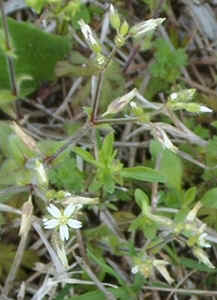 |
Common Name: Star Chickweed, Giant Chickweed
Other names: Birdseed, Winterweed
Genus: Stellaria pubera
Family: Caryophyllaceae
Mills River, North Carolina
April 13, 2002
 |
The attractive flowers of this native Chickweed are about 1/2 inch across and appear to have 10 petals. On closer examination, however, it will be found that each flower has only 5 petals, as do other members of the Pink family, but each petal is parted or divided into 2 linear segments. This southeastern perennial is relatively frequent in the deciduous woods of the mountains and piedmont of North Carolina. April - June [Justice, William S. and Bell, C. Ritchie, Wild Flowers of North Carolina. University of North Carolina Press, Chapel Hill, 1968]
Star Chickweed has large white flowers half an inch across, with petals so deeply cleft that it appears to have ten, rather than five petals. It is a perennial plant, with weak stems, opposite elliptical leaves, and flowers in clusters at the tops of the stems. It grows in woods in eastern U.S., from New Jersey to Illinois, and south to Florida and Alabama. [Forey, Pamela, American Nature Guides: Wild Flowers. Gallery Books, New York, 1990]
Five white petals, often mistaken for ten petals because each petal is so deeply cleft, give a star-like appearance in April and May, on stems 6 to 8 inches tall. Common on wooded slopes and roadsides up to 4,000 feet elevation. [Campbell, Carlos C., Hutson, William F., Sharp, Aaron J., Great Smoky Mountains Wildflowers, Fourth Edition. The University of Tennessee Press, Knoxville, 1977]
What may appear as 10 petals are really just five. Each petal is cut almost to its base giving a false impression. Divided petals are characteristic of the pink family. The flower has dark, globular anthers giving it a delicate look. It is sometimes called great chickweed because of its large, showy flowers (large by chickweed standards, anyway). The stem is marked with a row of tiny hairs which alternate sides at each node. The closely related Core's chickweed (Stellaria corei) has sepals longer than its petals and the upper leaves often have short stems. Mountain folklore says that an open chickweed flower guarantees a few hours without rain. Birds forage eagerly for this plant's seeds, hence the common name "chickweed". April - May [White, Peter, Wildflowers of the Smokies. Great Smoky Mountains Natural History Association, Gatlinburg, 1996]
Giant Chickweed, also known as Star Chickweed, this plant's 1/2-inch, white, starry flowers are often seen on rocky slopes early in the spring. The flower's five petals are so deeply notched that there appear to be ten. The weak stems are 4 to 10 inches long and have two vertical lines of fine hairs. The unstalked leaves are elliptic or oblong, 1/2 to 2 inches long, and pointed at both ends. The common chickweed (Stellaria media) is also found in scattered locations along the Parkway. It is similar to the giant chickweed but has leaf-stalks supporting short, ovate leaves and floral petals that are shorter than the sepals. The mouse-ear chickweed (Cerastium glomeratum) is also similar but has hairy, sticky stems and small, fuzzy, mouse-ear-like leaves. Other common names for this plant include birdseed, starweed, and winterweed. That the seeds are eaten by several species of birds accounts for the name "birdseed". The name "winterweed" probably comes from the plant's ability to grow very early in spring, even when there is still frost on the ground. The generic name, Stellaria, comes from the Latin word stella, meaning "star", being descriptive of the star-like flowers. The chickweeds are considered a delicacy in Europe, being a good substitute for spinach. When gathered early in the spring, before flowering, they are more tender than any other wild green. April - May [Alderman, J. Anthony, Wildflowers of the Blue Ridge Parkway. The University of North Carolina Press, Chapel Hill, 1997]
January February March April May June July August September October November December
Alphabetical Listings -- A B C D, E F G H I, J, K L M N, O P Q, R S T U, V W X, Y, Z
Family Listings -- A B C D, E F G H I, J, K L M N, O P Q, R S T U, V W X, Y, Z
Genus Listings -- A B C D, E F G H I, J, K L M N, O P Q, R S T U, V W X, Y, Z